|
 |
|
|
|
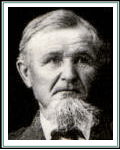  Groß Wokern or Gross Wokern is a
small village in the province of Mecklenburg-Vorpommern. When our
ancestors left to come to America in the 1870s, the region was called Mecklenburg-Schwerin. Even today, there are only about 1,100 people
in the village so it was probably much smaller when
August Heiden's
(left) family
lived in the village. Groß Wokern or Gross Wokern is a
small village in the province of Mecklenburg-Vorpommern. When our
ancestors left to come to America in the 1870s, the region was called Mecklenburg-Schwerin. Even today, there are only about 1,100 people
in the village so it was probably much smaller when
August Heiden's
(left) family
lived in the village.
August was born in this village in
1838 and he and his wife, Fredericka who he married in 1868, lived there until the family
left for America in 1873. Their first three children
Heinrich,
Ernst
and Meta were born in this village.
August was a brick mason so he might have had a slightly higher
status in the community compared to farm laborers and house
servants.
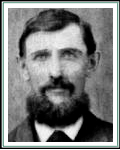 Also
born here in 1840 was
Heinrich Rambow II (right) who married Wilhelmina Milhan in 1868
about 6 years before they too emigrated to American in 1874. After
they settled within a few miles of each other in
Monroe County, Michigan, August helped build the Rambow's
house.
Eventually two of August's sons would marry two of Heinrich's
daughters. Mary Rambow became the wife of
William Carl Heiden
and Fredareka Rambow married
Herman
Heiden. Also
born here in 1840 was
Heinrich Rambow II (right) who married Wilhelmina Milhan in 1868
about 6 years before they too emigrated to American in 1874. After
they settled within a few miles of each other in
Monroe County, Michigan, August helped build the Rambow's
house.
Eventually two of August's sons would marry two of Heinrich's
daughters. Mary Rambow became the wife of
William Carl Heiden
and Fredareka Rambow married
Herman
Heiden.
In such a small town, there is little
doubt that the Rambows and
August Heiden were
well acquainted.
Gross Wokern is about 3 or 4 miles from the
larger town of Teterow. Nearby villages of Klein Wokern, Neu Wokern
and Nienhagen also figure in the lives of our German ancestors.
|
|
|
 |
 |
 |
|
|
-
Christina Maria Aullrich died
January14 1823
-
August Friedrich Anton Theodor
Heiden born January 27, 1838 baptized February 4
-
Christina Sophia Maria Elizabeth
Heiden born October 23, 1807 died November 30, 1887 (August's
mother)
-
Ernst Car Fritz Heiden born June 10,
1868 son of August and Rika Heiden.
-
Friederika Sophia Henrietta Heiden
born December 31, 1832
-
Meta Friedericka Henrietta Elisabeth
Heiden born December 23, 1870 daughter of August and Rika Heiden.
-
Carl Christian Johann Frederick
Martin Milhan born October 27, 1849 - Emigrated to America and
lived near his sister # 12 below.
-
Christoph Carl August Ludwig Milhan
born February 17, 1863 - Emigrated to America and lived near his
sister # 12 below.
-
Fredericka Marie Caroline Johanna
Milhan born August 17, 1855 - Emigrated to America and lived
near her sister # 12 below.
-
Johann Joachim Friederick Milhan
born July 23, 1823, married November 29, 1848 and died
February 20, 1868. (Mary (Rambow) Heiden's grandfather)
-
Wilhelm Friedrick Heinrich Ludwig
Milhan born March 20, 1858 - Emigrated to America and lived near
her sister # 12 below.
-
Wilhelmina Augusta Sophia Milhan
born September 1, 1847 (Mary (Rambow) Heiden's mother)
-
Maria Sophia Fredericke Möller born
August 10, 1816 died April 10, 1874
-
Bertha Rambow born December 15, 1872
daughter of
Heinrich Rambow.
-
Friedrich L. Rambow born December
24, 1869 son of Heinrich Rambow.
-
Heinrich Christoph Jochim born June
12,1799 married November 8, 1839 died May, 1867
-
Heinrich Ernst Carl Dietrich Rambow
II born March 31, 1840 married November 8, 1868 (Mary (Rambow) Heiden's
father)
-
Henriette Wilhelmine Maria Rambow
born before February 2, 1853 died February 2, 1853
-
Joachim Gottfried Rambow born March
12, 1855
-
Johanna Henrietta Dorothea Rambow
born January 27, 1849
-
Julianna Maria Dorothea Rambow born
June 28, 1845 died July 21, 1853
-
Maria Sophia Dorothea Rambow born
March 4, 1838 died April 4, 1842
-
Nicolaus Heinrich Rambow died July
27, 1835, he was the father of
Heinrich Rambow, Sr.
-
Friedrich Leonhard Heinrich Stuve
born September 23, 1813 residence 1844
-
Isabe Catharina Sophia Teschenow
residence
|
 |
1867 Census of Gross Wokern
Showing Maria and her son, August
|
|
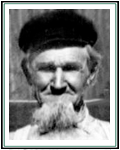 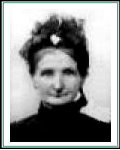
This periodic census for the hometown of August Heiden (left)
includes his mother, Maria who was born in 1811 and her two
children. August born in 1838 and Ricka Schmitt (right) born in
1833 along with her four children, August, Heinrich, Helmuth and
Marta.
|
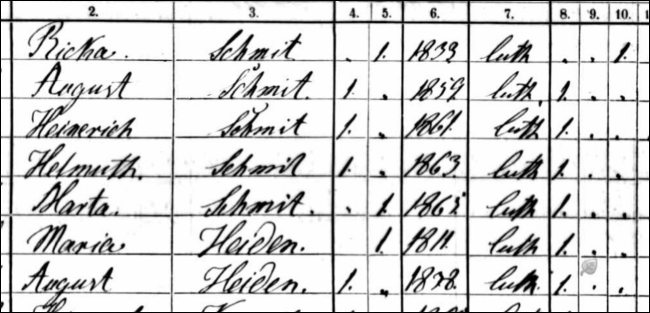
|
 |
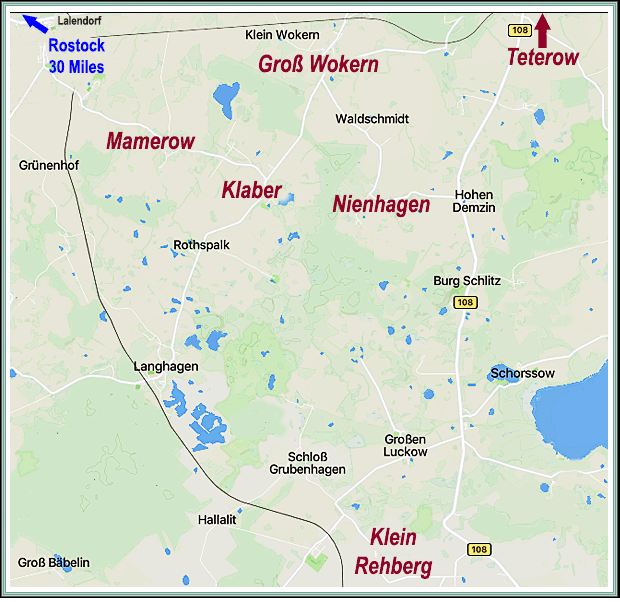 |
 |

 During
my trip to this area of Germany in 1996, I spent some time wandering
around this village which was at
the
center of our branch of the Heiden family. During
my trip to this area of Germany in 1996, I spent some time wandering
around this village which was at
the
center of our branch of the Heiden family.
 Gross Wokern is basically a very
small town with a main street and a few side streets. It is
surrounded by farm land and it was easy to visualize people of the
town walking out to the large estates each day to do their work.
Unlike in the U.S. Midwest, there are very few houses in the
country. There is a large house and farmstead surrounded by miles of
open farm land. More on this
Topic. Gross Wokern is basically a very
small town with a main street and a few side streets. It is
surrounded by farm land and it was easy to visualize people of the
town walking out to the large estates each day to do their work.
Unlike in the U.S. Midwest, there are very few houses in the
country. There is a large house and farmstead surrounded by miles of
open farm land. More on this
Topic.
|
 |
 |
|
|
|
Many of the houses in the village
look as if they could have been there at the time of our ancestors.
They are well maintained and up to date with neat, but small
landscapes. In many European countries, zoning type laws help to
maintain the
|
|
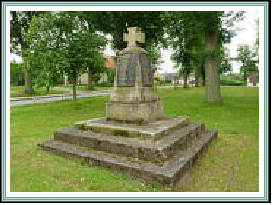
In the middle of the town in the middle of a boulevard type of
street was a memorial to those who died in World War I. The town has
only about 1,100 people today so it must have been much smaller back
in the late 19th and early 20th centuries. Still, there were about
40 names of men from Gross Wokern who had been killed in the war. |
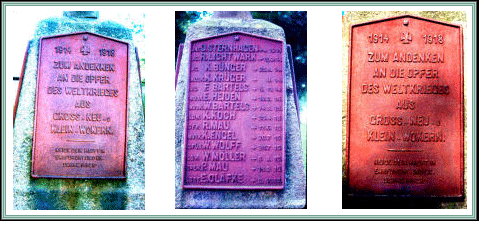 |
|
|
|
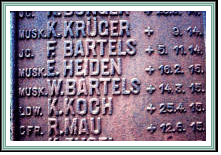 Listed
on one of the plaques was Musk. E. Heiden + 16. 2. 15. This means
that someone named E. Heiden who was a
Musketier
which was the equivalent to a private in the U.S. Army, died on
February 16, 1915. Given the small size of this community, it would
seem very likely that this person would be of some relation to our
ancestors...but we don't know for certain. Listed
on one of the plaques was Musk. E. Heiden + 16. 2. 15. This means
that someone named E. Heiden who was a
Musketier
which was the equivalent to a private in the U.S. Army, died on
February 16, 1915. Given the small size of this community, it would
seem very likely that this person would be of some relation to our
ancestors...but we don't know for certain. |
|
 |
 |
|
This rock, obviously very old, church
stands in Gross Wokern. It was probably the church where August,
Rika and their children worshiped before coming to America. The
Lutheran church always seemed to a big part of their lives and the
lives of their children.
There were a few headstones around
the church grounds but, like all other churches we visited on this
journey, the headstones were all for people who died in the recent
several decades. This is because of the burial customs in many
European nations which maximize the use of limited amounts of land.
For more on these customs,
click here.
|
|
|
 |
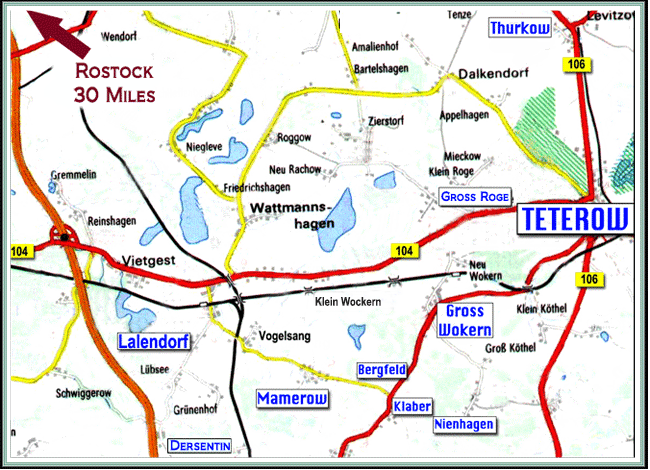 |
| |
|
|
|
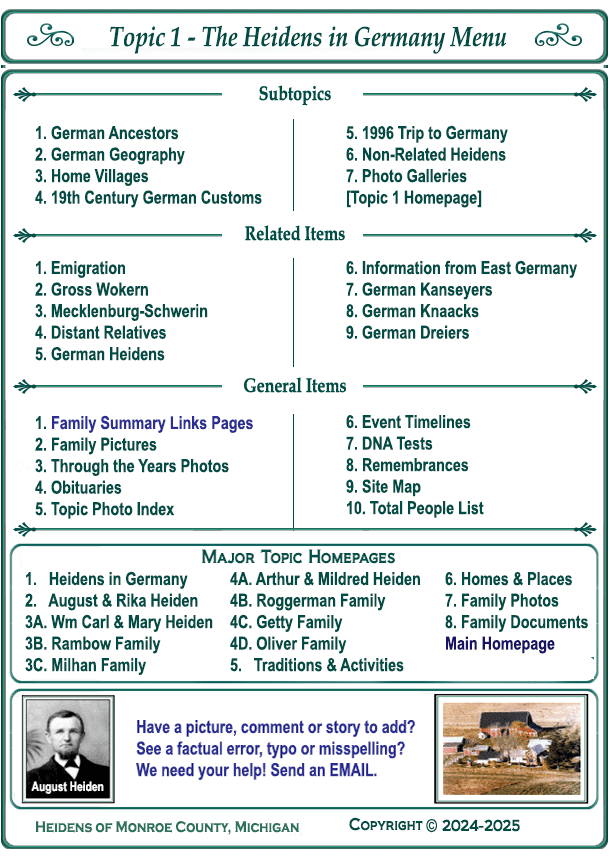
|
|

